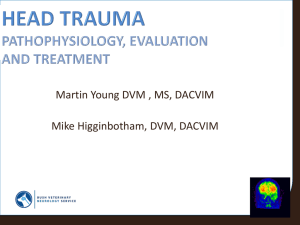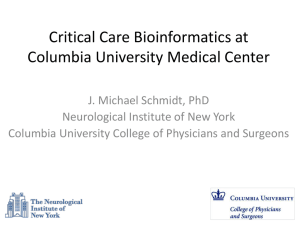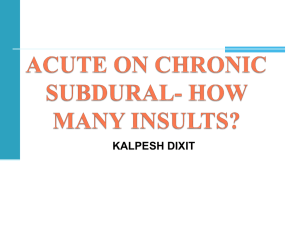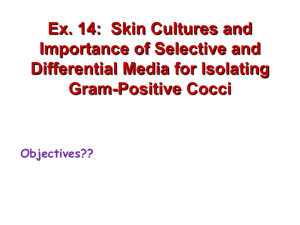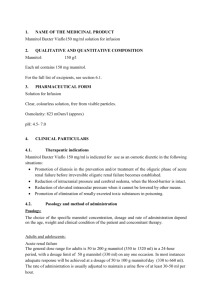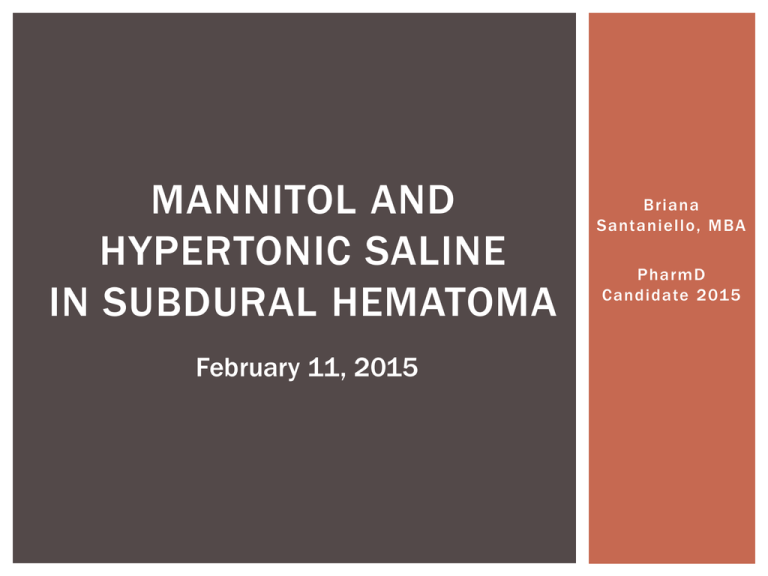
MANNITOL AND
HYPERTONIC SALINE
IN SUBDURAL HEMATOMA
February 11, 2015
Briana
Santaniello, MBA
PharmD
Candidate 2015
OBJECTIVES
After reviewing the patient case, the audience should be able
to:
Recognize the treatment options for a subdural hematoma
Describe the mechanisms of action of these agents
Analyze available literature comparing the ef fectiveness of
these treatments
Determine if current guidelines should be updated to reflect
recent literature suggestive of dose change
MEET THE PATIENT: MD
CC: Unresponsive s/p witnessed fall with subsequent emesis
HPI:
83 yo F
Sustained witnessed fall
Found vomiting by son-in-law
Felt unwell & requested to lay down
Progressively more somnolent
Son-in-law called 9-11.
PMH/PSH: sick sinus syndrome s/p pacemaker, HTN, HLD,
osteoporosis, hypothyroidism
MEET THE PATIENT: MD (CONTINUED)
FH: unavailable
SH: lives with husband who has dementia; babysitter of 3 year
old grandchild; has 3 children
Allergies: midazolam
Reaction – not specified
Home medications (doses unknown):
warfarin
amlodipine
levothyroxine
simvastatin
MEET THE PATIENT: MD (CONTINUED)
Physical examination/presentation to ED:
Somnolent
Contusion/laceration to R side of face & bridge of nose
Pupils equal and sluggishly reactive (3 mm bilaterally)
Vomitus and blood obstructing airway
Presents to ED:
GCS 9
Decompensation
ensued & left
pupil became
fixed & dilated:
GCS 7
Intubation
VITAL SIGNS AND PERTINENT
INFORMATION
Upon Arrival
Decompensation
150/84
200/88
O2 sat
97%
88%
Pulse (bpm)
105
80
RR (breaths/min)
22
20
POC (mg/dL)
161
------
INR
------
2.3
BP (mmHg)
ADDITIONAL INFORMATION
Height: 162 cm
Weight: 66.8 kg
Serum creatinine: 0.9 mg/dL
Round to 1 based on age > 65 years old
Creatinine clearance: 40.9 mL/min
MEDICATIONS GIVEN IN ED
Decision to
intubate
•fentanyl 100 mcg IV
•etomidate & rocuronium
•propofol
Signs of
impending
herniation
•Contusion to head
•Pupil blown
•Decerebrate posturing
Suspected
subdural
hematoma
•mannitol 100 g IV
•Sent for CT scan
RESULTS OF CT SCAN
Massive holohemispheric subdural hematoma: Left
TREATMENT OF SUBDURAL HEMATOMA
Surgical
hematoma
evacuation
Craniotomy
Burr hole trepanation/trephination
Decompressive craniectomy
Nonpharmacologic
Pharmacologic
Head elevation at 30° angle
Osmotic diuretics/Hyperosmolar therapy
-Brain Trauma Foundation’s 2007 Guidelines for the Management of Severe Traumatic Brain Injury
-Wilkins RH, Rengachary SS. Neurosurgery. 2nd ed. New York:. McGraw Hill;1996:2603-2720
URGENT SURGICAL PROCEDURES IN
ANTICOAGULATED PATIENTS
Reversal of anticoagulant is necessary
Immediate cessation of anticoagulants & antiplatelets
+
vitamin K 10 mg by slow IV infusion
or
recombinant human factor VIIa (rFVIIa)
or
fresh frozen plasma (FFP)
or
prothrombin complex concentrate (PCC)
PHARMACOLOGICAL OPTIONS
MANNITOL
Mechanism of action:
HYPERTONIC SALINE
Mechanism of action
osmotic gradient between
CSF and subarachnoid space
osmotic gradient: intracellular
fluid moves extracellularly
↓ subarachnoid space
pressure
↑ intravascular blood volume
↑ plasma sodium
↓ICP
↓ brain water
Fink ME. Osmotherapy for Intracranial Hypertension: Mannitol Versus Hypertonic Saline. Continuum Lifelong Learning Neurol
20012;18(3):640-654.
MANNITOL IN SUBDURAL HEMATOMA
Available formulations:
20% solution
25% in vials
Dose:
0.5 to 1 g/kg
Doses < 0.5 g/kg: less efficacious, shorter DOA
Administration
IV bolus over 20 minutes
Requires filter
crystallization
Fink ME. Osmotherapy for Intracranial Hypertension: Mannitol Versus Hypertonic Saline. Continuum Lifelong Learning Neurol
20012;18(3):640-654.
MANNITOL IN SUBDURAL HEMATOMA
(CONTINUED)
Adverse Ef fects
Electrolyte abnormalities (hypernatremia, hypokalemia, metabolic
acidosis)
Hypotension
Monitoring
ICP
Serum osmolarity
DNE 320 mOsm/L
Osmotic gradient: ideally ≥ 10 mOsm
Fink ME. Osmotherapy for Intracranial Hypertension: Mannitol Versus Hypertonic Saline. Continuum Lifelong Learning Neurol 2012;18(3):640-654.
Mannitol. Package Insert. Baxter Health Care. 2011. Old Toongabbie, NSW.
MANNITOL IN SUBDURAL HEMATOMA
(CONTINUED)
Complications
CHF with pulmonary edema
Acute renal failure
Rebound hypertension with cessation of therapy
Contraindications
Hypersensitivity
Anuria from severe renal disease
Severe pulmonary edema, HF
Hyperosmolarity prior to initial dose
Severe dehydration
Metabolic edema
Progressive renal disease
Fink ME. Osmotherapy for Intracranial Hypertension: Mannitol Versus Hypertonic Saline. Continuum Lifelong Learning Neurol 2012;18(3):640-654.
Mannitol. Package Insert. Baxter Health Care. 2011. Old Toongabbie, NSW.
HYPERTONIC SALINE IN SUBDURAL
HEMATOMA
Available formulations: 2%, 3%, 5%, 7%, 23.4%
Less potent diuretic than mannitol
↔ intravascular volume
↑ blood pressure, CO, cerebral blood flow
Dose: 5-6 mL/kg bolus dose of 3% administered over 30 minutes
Can vary depending on hospital’s protocol
Administration
IV bolus
Preferably administered via central line
high concentration
Can be administered peripherally in trauma room
Maximum of 100 mL/hr for up to 5 hours per site
Fink ME. Osmotherapy for Intracranial Hypertension: Mannitol Versus Hypertonic Saline. Continuum Lifelong Learning Neurol
20012;18(3):640-654.
HYPERTONIC SALINE IN SUBDURAL
HEMATOMA (CONTINUED)
Side Ef fects
Hypokalemia
supplemental potassium
Dehydration
Monitoring
serum Na+ (ideally < 160 mEq/L or < 180 mEq/L in refractory cases)
serum osmolarity (target < 320 mOsmol/L)
fluid status (intake/output)
body weight
CXR (pulmonary edema)
Fink ME. Osmotherapy for Intracranial Hypertension: Mannitol Versus Hypertonic Saline. Continuum Lifelong Learning Neurol
20012;18(3):640-654.
HYPERTONIC SALINE IN SUBDURAL
HEMATOMA (CONTINUED)
Complications
hyperchloremic acidosis
With repeated doses or continuous infusion
Central pontine myelinolysis (CPM)
Renal failure
Cardiac arrhythmias
Hemolysis
CHF with pulmonary edema
Contraindications
Chronic hyponatremia (i.e. SIADH) due to risk of CPM
Fink ME. Osmotherapy for Intracranial Hypertension: Mannitol Versus Hypertonic Saline. Continuum Lifelong Learning Neurol
20012;18(3):640-654.
MANNITOL VS. HYPERTONIC SALINE
Double Blind Study of Hypertonic Saline vs Mannitol in the
Management of Increased Intracranial Pressure (ICP)
Study withdrawn prior to enrollment
Unfeasible timeline to consent prior to intervention
No Class I evidence supporting use of one agent over the
other
Mortazavi et al: literature review with meta -analysis
comparing hypertonic saline to mannitol
MANNITOL VS. HYPERTONIC SALINE
Mortazavi et al: PubMed literature search of all clinical
studies in which HTS was used for elevated ICP
12 compared hypertonic saline with mannitol
7 RCTs, 1 prospective non-randomized study, 4 retrospective studies
Results:
3: hypertonic saline not clinically superior to mannitol for ICP
reduction/outcome
9: suggested hypertonic saline is clinically superior to mannitol for ICP
reduction
Mortazavi MM, Romeo AK, Deep A, et al. Hypertonic saline for treating raised intracranial pressure: literature review with metaanalysis. J Neurosurg 2012;116:210-221
MANNITOL VS. HYPERTONIC SALINE
Among the 9 trials supporting use of hypertonic saline over
mannitol:
Total of 236 subjects among the 9 trials
Different concentrations of hypertonic saline used in each trial
Some trials used continuous infusion; others used bolus dose
Conflicting results on mortality in hypertonic saline groups
HYPERTONIC SALINE IN SUBDURAL
HEMATOMA (CONTINUED)
Neurocritical Care Society practice patterns survey
mannitol: 45.1%
More comfortable with agent, no central venous access required, more
effective
hypertonic saline: 54.9%
Fewer side effects, better long-term benefits, less of a rebound effect,
easier titration, less associated with renal failure
Mortazavi MM, Romeo AK, Deep A, et al. Hypertonic saline for treating raised intracranial pressure: literature review with metaanalysis. J Neurosurg 2012;116:210-221
HIGH-DOSE MANNITOL
Randomized trial in 178 comatose adult patients diagnosed with acute
traumatic subdural hematoma over 4 year period
Randomly assigned to 1 of 2 groups:
High-dose mannitol group: 91 patients
Conventional-dose mannitol group: 87 patients
All were administered 0.6-0.7g/kg mannitol as fast IV infusion, followed by
normal saline solution administered via rapid IV infusion at 6-7 mL/kg
25 to 30 minutes later, high-dose mannitol group received additional 0.6-0.7g/kg dose of
mannitol when pupillary widening was still observed
Cruz J, Minoja G, Okuchi G. Improving Clinical Outcomes from Acute Subdural Hematomas with the Emergency Preoperative
Administration of High Doses of Mannitol: A Randomized Trial. Neurosurgery 2001;49(4):864-871.
HIGH-DOSE MANNITOL
All underwent standard craniotomies with clot removal, received fentanyl
and propofol, and had head elevation 30° post-craniotomy
Monitored via ECG, pulse oximetry, expired PCO 2 , ICP, MAP
Results:
6 months after acute traumatic brain injury, mortality rates were as follows:
High-dose mannitol: 14.3% (13 patients)
Conventional-dose mannitol: 25.3% (22 patients)
P < 0.01
Overall clinical outcomes significantly better in patients who received high -dose
mannitol (p < 0.01)
Cruz J, Minoja G, Okuchi G. Improving Clinical Outcomes from Acute Subdural Hematomas with the Emergency Preoperative
Administration of High Doses of Mannitol: A Randomized Trial. Neurosurgery 2001;49(4):864-871.
MANNITOL FOR MD
MD weighs 66.8 kg
1 g/kg x 66.8 kg = 66.8 g
MD given 100 g
???
THOUGHTS ON APPROPRIATE DOSE
Traditionally dosed 1g/kg
CrCl: 40.9 mL/minute
Poor prognosis
Potential for renal harm balanced with potential for better ICP
reduction
TAKE HOME POINTS
REFERENCES
1 . B r a i n Tr a u m a F o u n d a t i o n ’ s 2 0 0 7 G u i d e l i n e s f o r t h e M a n a g e m e n t o f S e v e r e Tr a u m a t i c B r a i n
Injury
2 . W i l k i n s R H , R e n g a c h a r y S S . N e u r o s u r g e r y. 2 n d e d . N e w Yo r k : . M c G r a w H i l l ; 1 9 9 6 : 2 6 0 3 - 27 2 0
3 . F i n k M E . O s m o t h e r a p y f o r I n t r a c r a n i a l H y p e r t e n s i o n : M a n n i t o l Ve r s u s H y p e r t o n i c S a l i n e .
Continuum Lifelong Learning Neurol 20012;18(3):640 -654.
4 . M a n n i t o l . P a c k a g e I n s e r t . B a x t e r H e a l t h C a r e . 2 0 1 1 . O l d To o n g a b b i e , N S W.
5. Mor tazavi MM, Romeo AK, Deep A , et al. Hyper tonic saline for treating raised intracranial
p r e s s u r e : l i t e r a t u r e r e v i e w w i t h m e t a - a n a l y s i s . J N e u r o s u r g 2 0 1 2 ; 1 1 6 : 2 1 0 - 2 21
6. Cruz J, Minoja G, Okuchi G. Improving Clinical Outcomes from Acute Subdural Hematomas with
t h e E m e r g e n c y P r e o p e r a t i v e A d m i n i s t r a t i o n o f H i g h D o s e s o f M a n n i t o l : A R a n d o m i z e d Tr i a l .
N e u r o s u r g e r y 2 0 0 1 ; 4 9 ( 4 ) : 8 6 4 - 8 71
.
QUESTIONS?
Thank You!

